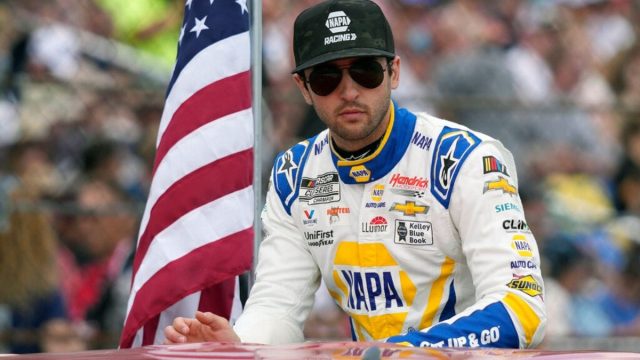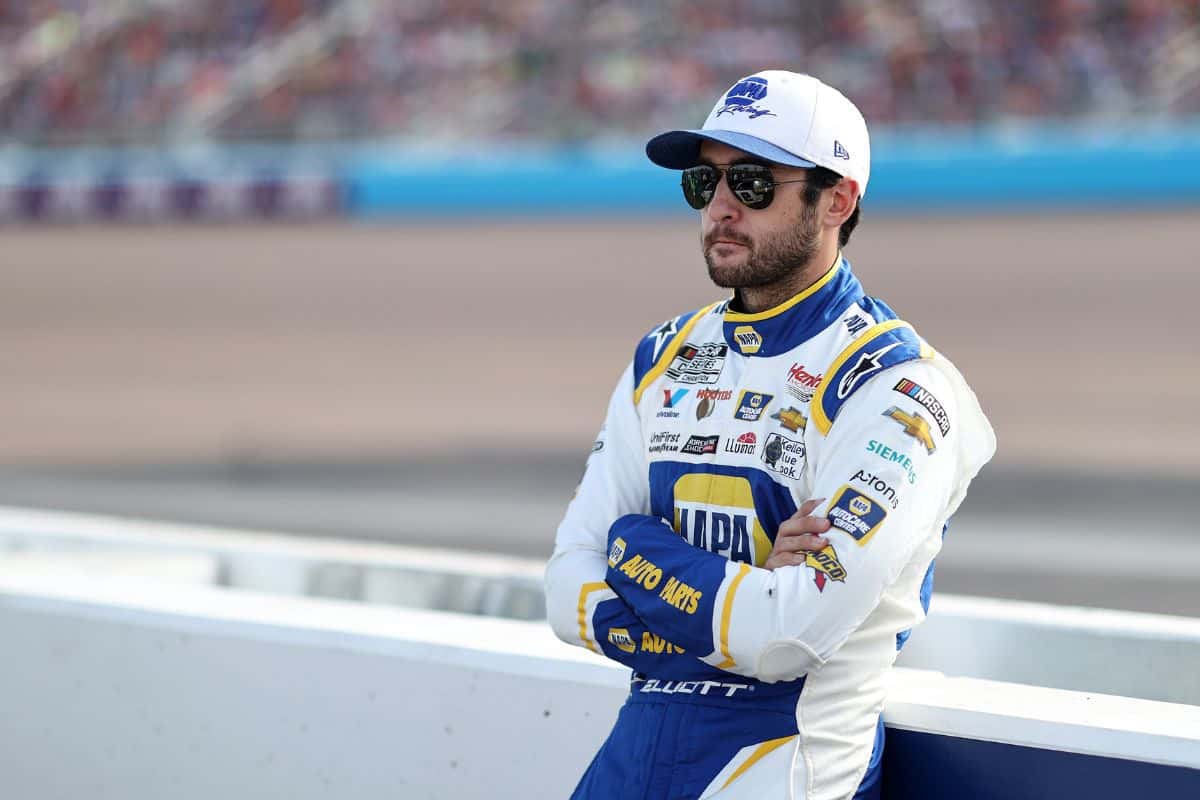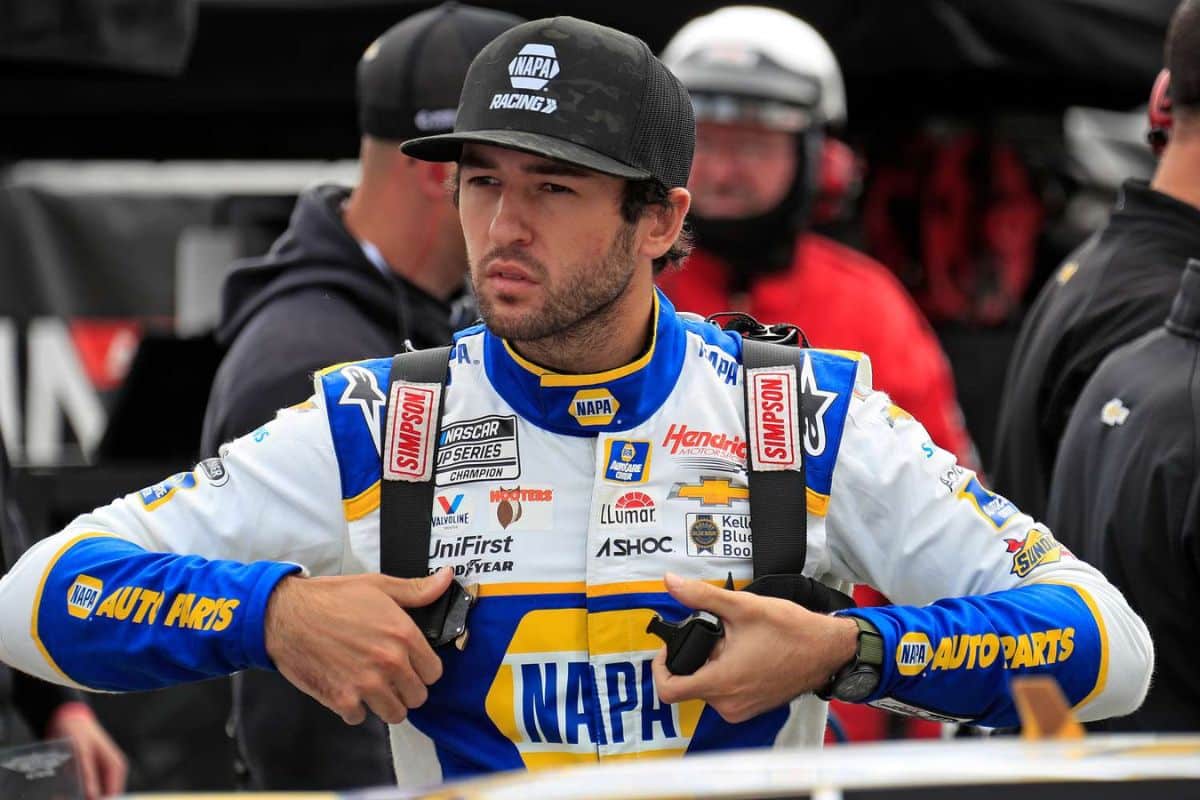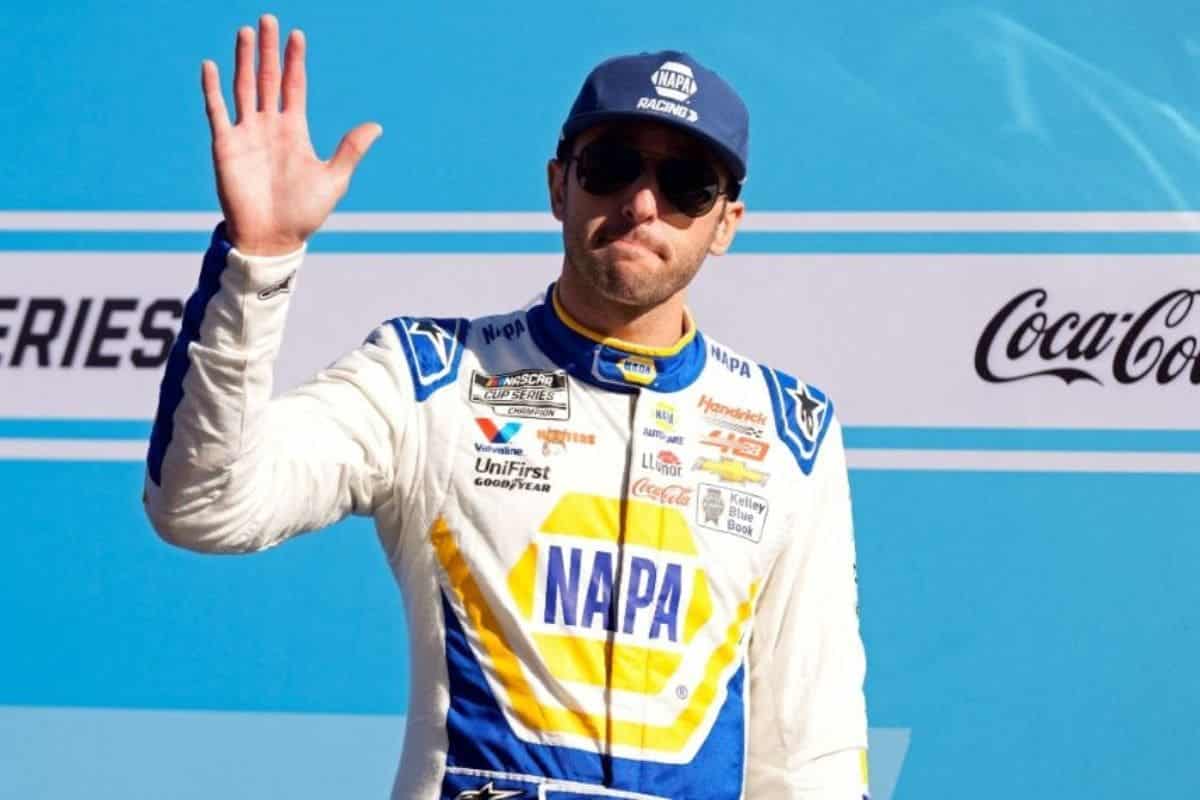Chase Elliott Voices Frustration Over NASCAR: Chase Elliott’s recent outburst at New Hampshire Motor Speedway has reignited a long-simmering debate within the NASCAR community. The 2020 Cup Series champion’s frustration with the wet-tire rule, which mandates the use of rain tires under certain conditions, has cast a spotlight on the tension between safety regulations and strategic freedom. During the USA Today 301 race, Elliott’s inability to switch to slick tires on a rapidly drying track compromised his performance and prompted him to voice his dissatisfaction publicly. This incident has spurred discussions about whether the current rules are serving the sport’s best interests or stifling the very essence of competitive racing.
Background: Testing and Implementation
In 2021, NASCAR initiated tests on rain tires to ensure that races could continue safely in wet conditions. The tests were primarily conducted on short tracks with flatter sections, allowing the organization to assess the performance and safety of these specialized tires under controlled conditions. These initial trials were crucial in determining whether the use of rain tires could be a viable solution for the sport.
As the tests progressed, NASCAR collected valuable data on the behavior of rain tires on different track surfaces. The focus was on maintaining the balance between safety and competitive racing. Feedback from drivers and teams was also considered to fine-tune the tire specifications. The successful tests led to the formal introduction of the wet-tire rule in 2023.
However, NASCAR decided to restrict the use of wet-weather tires to tracks under a mile in length. This decision was based on the findings from the tests, which indicated that shorter tracks provided a safer environment for racing on rain tires. The rule aimed to mitigate the risks associated with wet conditions while ensuring that the races could proceed without significant disruptions.
The wet-tire rule marked a significant shift in NASCAR’s approach to weather-related challenges. Prior to this, races were often delayed or canceled due to rain, leading to logistical issues and dissatisfaction among fans and teams. The introduction of rain tires was seen as a proactive measure to address these concerns and keep the sport moving forward.
Despite the positive intentions behind the rule, it soon became apparent that not all drivers and teams were on board with the new regulation. The limited application of the rule and the mandatory use of wet tires in certain conditions sparked debates about the strategic implications and the overall impact on the racing experience.
Elliott’s Discontent at New Hampshire
Chase Elliott’s frustration with the wet-tire rule came to a head during the USA Today 301 race at New Hampshire Motor Speedway on June 23rd, 2024. As the 2020 Cup Series champion, Elliott’s opinions carry significant weight in the NASCAR community, and his dissatisfaction was noticeable. The race started under dry conditions, but a sudden downpour led to NASCAR mandating the use of wet-weather tires.
Elliott found himself struggling on the quickly-drying track, unable to switch to slicks due to the rigid enforcement of the wet-tire rule. This inability to adapt to changing track conditions compromised his race strategy, causing a noticeable dip in his performance. The frustration was evident in his communication with his team, where he vented his anger over the constraints imposed by the rule.
The situation highlighted a key issue with the wet-tire rule: its lack of flexibility. Elliott’s experience showed the need for a more adaptive approach that allows teams to make strategic decisions based on real-time track conditions. The rigid enforcement of the rule not only affected Elliott’s performance but also raised questions about its overall effectiveness in maintaining competitive fairness.
Elliott’s struggles during the race were not isolated incidents. Other drivers also expressed similar concerns, pointing out that the rule often put them at a disadvantage. The quickly-drying track conditions at New Hampshire exposed the limitations of a one-size-fits-all approach to wet-weather racing. The rigidity of the rule failed to account for the dynamic nature of racing environments.
Drivers Call for Strategic Freedom
The backlash against the wet-tire rule extended beyond Chase Elliott. Several drivers and teams echoed his sentiments, arguing that the rule reduced the strategic freedom that is a hallmark of NASCAR racing. In an interview with FOX Sports journalist Bob Pockrass, Elliott articulated a widely shared frustration: the wet-tire rule took away the ability for teams to call their races as they saw fit.
“Part of the appeal to the NASCAR Cup Series is having freedom to call your race like you want to call it. I just felt like that was totally taken out of the equation last weekend and that was a bummer.” – (Elliott)
Elliott’s comments resonated with many in the NASCAR community. The essence of NASCAR racing lies in the strategic decisions made by teams and drivers. Whether it’s choosing the right moment to pit, adjusting tire pressures, or selecting the appropriate tire compound, these decisions are integral to the sport’s competitive nature. The wet-tire rule, in its current form, seemed to strip away a crucial aspect of this strategic depth.
“But just from my standpoint, it would have been nice to, even if they were going to make you stay on the wet, to at least give you the opportunity to pit or stay out.” – (Elliott)
Other drivers quickly joined the conversation, supporting Elliott’s call for more autonomy in making tire-related decisions. They pointed out that while safety is paramount, the rigid application of the wet-tire rule often led to suboptimal racing conditions. Drivers found themselves on tires that were not suited to the rapidly changing track conditions, resulting in compromised performance and, in some cases, increased risks.
The debate highlighted a fundamental tension within the sport: balancing safety regulations with the need to preserve the strategic complexity that defines NASCAR racing. Drivers argued that the current rule tipped this balance too far in favor of safety, at the expense of strategic flexibility. They called for a more distinct approach that would allow teams to make tire decisions based on real-time conditions.
Also on the topic of wet-weather tires, Chase Elliott said it is pivotal that they get to a point where teams should be allowed to make the decision of when to pit and change tires. pic.twitter.com/n4fLcrlqi3
— Bob Pockrass (@bobpockrass) June 30, 2024
Race Recap: Elliott’s Rollercoaster Day
The USA Today 301 race at New Hampshire Motor Speedway was a rollercoaster for Chase Elliott. Starting from pole position, Elliott had high hopes for a strong performance. He led the race confidently until lap 42, showcasing the speed and skill that have made him a formidable competitor in the Cup Series. However, the strategic landscape of the race began to shift dramatically.
Christopher Bell, driving the 20 Toyota, executed a series of strategic decisions that saw him take the lead from Elliott. Bell’s team made the most of the changing conditions, and their timely calls allowed Bell to capitalize on opportunities that Elliott could not. By the end of Stage 1, Elliott found himself in third position, trailing behind Joey Logano and Bell.
Stage 2 presented new challenges. An untimely caution flag caused by Daniel Hemric’s spin disrupted the rhythm of the race. Elliott, who had been running in a strong position, was caught out by the caution and found himself slipping further down the order. By the end of Stage 2, he had dropped to ninth place, a significant setback given his strong start.
The final stage was where things truly unraveled for Elliott. Rain brought all cars to a halt in the pit lane, and the decision was made to switch to wet-weather tires. As the track conditions improved, teams were instructed to remain on rain tires, despite the drying surface. This decision proved to be a critical turning point in the race.
Elliott struggled to adapt to the wet tires on a track that was no longer suited for them. The reduced grip and slower lap times hampered his performance, causing him to lose further positions. By the end of the final stage, Elliott had dropped to 18th place. Despite the disappointing finish, he managed to secure 29 points from the race, which helped him maintain his lead in the drivers’ standings.
Final Stage Struggles and Championship Standings
The final stage of the USA Today 301 was particularly challenging for Chase Elliott and his team. As rain began to fall, the decision to switch to wet-weather tires was made to ensure safety. However, the drying track soon rendered these tires less effective. Elliott, along with other drivers, found himself grappling with the reduced grip and slower lap times associated with the wet tires.
The situation was further complicated by inconsistent track conditions. While some parts of the track were dry, others remained wet, necessitating the continued use of rain tires. This uneven surface made it difficult for drivers to find a consistent rhythm, and many struggled to maintain their pace. Elliott’s inability to switch to slicks meant he was stuck on tires that were not optimized for the conditions.
As the race progressed, Elliott’s position continued to deteriorate. The dynamic nature of the track required constant adjustments, but the rigid application of the wet-tire rule left him with limited options. His performance suffered as a result, and he eventually finished the race in 18th place. This was a disappointing outcome for a driver who had started from pole position and led the race early on.
Despite the challenging race, Elliott’s accumulation of 29 points allowed him to maintain a 40-point lead over Denny Hamlin in the drivers’ standings. This points haul was crucial in preserving his position at the top of the leaderboard. Additionally, Elliott and Kyle Larson were now tied in the championship with 620 points each, highlighting the competitive nature of the season.
A Call for Change
Chase Elliott’s criticism of the wet-tire rule has sparked a significant debate within the NASCAR community. While the rule was introduced with the best of intentions, its impact on strategic decision-making has been called into question. Elliott’s experience at New Hampshire Motor Speedway highlighted the need for a more adaptive approach that allows teams to respond to real-time track conditions.
The broader NASCAR community has echoed Elliott’s sentiments, with many drivers and teams calling for greater strategic freedom. The rigid enforcement of the wet-tire rule has been seen as a constraint that reduces the essence of NASCAR racing. The push for change is driven by a desire to preserve the strategic depth and competitive spirit that define the sport.
As discussions continue, it is clear that NASCAR must find a way to balance safety regulations with the need for strategic flexibility. The current wet-tire rule, while well-intentioned, may need to be reevaluated and adjusted to better align with the dynamic nature of racing. The feedback from drivers like Elliott will be crucial in shaping future regulations.
The call for change is not just about one race or one driver; it reflects a broader concern within the sport. NASCAR’s ability to adapt and respond to these concerns will be a key factor in maintaining the integrity and excitement of the competition. The wet-tire rule debate is an opportunity for the sport to evolve and enhance the racing experience for drivers, teams, and fans.
News in Brief: Chase Elliott Voices Frustration Over NASCAR
Chase Elliott’s vocal criticism of NASCAR’s wet-tire rule has resonated deeply within the racing community, highlighting a critical issue that demands attention. The rigid enforcement of this rule, though well-intentioned for safety, has accidentally restricted the strategic freedom that defines NASCAR racing.
Elliott’s struggles at New Hampshire, shared by other drivers, show the need for a more adaptive approach that balances safety with the dynamic nature of racing conditions. As NASCAR officials and teams engage in discussions to address these concerns, the aim will be to refine the regulations in a way that upholds the integrity and excitement of the sport.
Elliott’s demand for change has sparked a necessary conversation, paving the way for potential reforms that could enhance the safety and competitive spirit of NASCAR.
ALSO READ: Chase Elliott Praises Kevin Harvick’s Career With a Clever Nod



